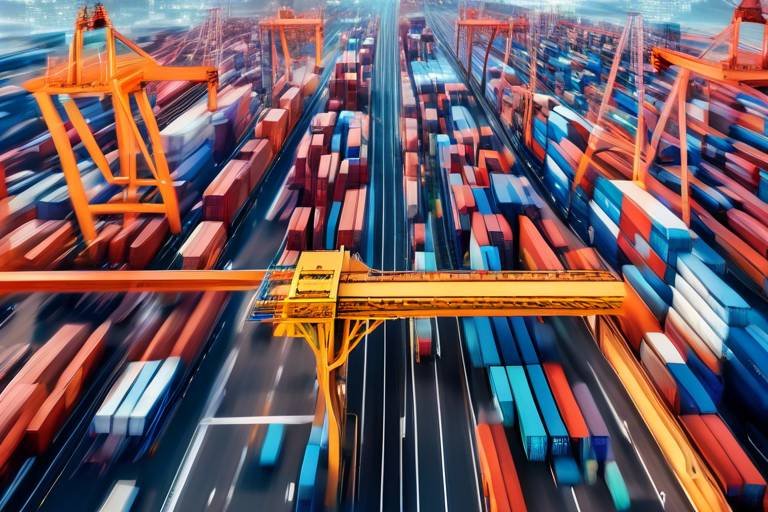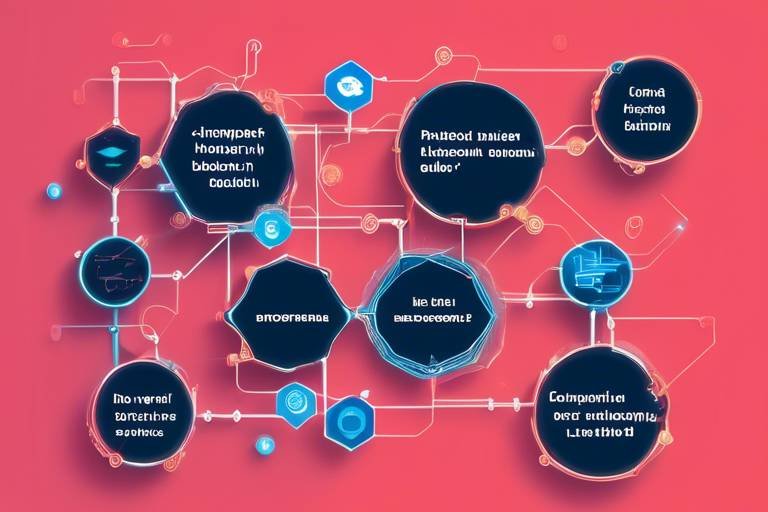How Blockchain Technology is Enhancing Public Safety Measures
In today's rapidly evolving world, ensuring public safety has become more critical than ever. The emergence of blockchain technology is paving the way for innovative solutions that can significantly enhance safety measures within communities. But what exactly is blockchain, and how can it be a game-changer for public safety? This article delves into the transformative impact of blockchain on public safety, highlighting its potential applications, benefits, and challenges in creating safer communities. From law enforcement to emergency response, blockchain is set to revolutionize the way we think about safety and security.
At its core, blockchain is a decentralized digital ledger that records transactions across multiple computers. This means that once a piece of information is added to the blockchain, it becomes nearly impossible to alter or delete, ensuring a high level of security and transparency. In the context of public safety, this decentralized nature allows for a more trustworthy system where data integrity is paramount. Imagine a world where every transaction related to law enforcement or emergency services is recorded in an immutable ledger—this is the promise of blockchain technology.
Blockchain technology is poised to enhance the operations of law enforcement agencies significantly. By improving evidence management, facilitating data sharing, and ensuring secure storage solutions, blockchain can lead to more effective crime prevention and response strategies. In a field where trust is essential, the ability to provide a transparent and tamper-proof system is revolutionary.
One of the most critical aspects of law enforcement is managing evidence. Blockchain ensures the integrity and chain of custody of evidence, which is vital for maintaining trust in the judicial process. With every piece of evidence logged into the blockchain, its history is preserved, reducing the risks of tampering or mishandling. This not only boosts confidence in the legal system but also enhances the chances of successful prosecutions.
Furthermore, blockchain provides secure and immutable storage solutions for sensitive law enforcement data. Traditional data storage methods can be vulnerable to breaches and unauthorized access, but with blockchain, data is encrypted and distributed across a network, making it far more secure. Law enforcement agencies can rest easy knowing that their vital information is protected against cyber threats.
Collaboration is key in tackling crime effectively. Blockchain facilitates seamless data sharing among different law enforcement agencies, improving overall collaboration and efficiency. Instead of relying on outdated systems that can be slow and cumbersome, agencies can access real-time data on criminal activities, missing persons, and other critical information. This interconnectedness can lead to faster response times and more informed decision-making.
Blockchain technology can also empower community safety initiatives. By fostering transparency and accountability in local governance and public service delivery, communities can work together to create safer environments. For instance, local governments can use blockchain to track the allocation of resources for public safety projects, ensuring that funds are used effectively and responsibly.
In times of crisis, every second counts. Blockchain technology can streamline emergency response operations, ensuring timely and coordinated actions during disasters. By providing real-time access to critical data, first responders can improve their situational awareness and make informed decisions that save lives.
Imagine a scenario where a natural disaster strikes, and first responders need immediate access to information about affected areas. With blockchain, they can obtain real-time data on resource availability, affected populations, and ongoing rescue efforts. This level of access can significantly enhance their ability to respond effectively and efficiently.
Moreover, blockchain can optimize resource allocation in emergency situations. By tracking where aid and support are needed most, first responders can ensure that assistance reaches those in need more effectively. This not only maximizes the impact of emergency resources but also builds trust within the community, knowing that help is being administered where it's most required.
Despite its potential, implementing blockchain technology in public safety does come with challenges. Issues such as scalability, regulatory concerns, and the need for widespread adoption must be addressed for blockchain to realize its full potential in enhancing public safety.
One of the primary challenges is scalability. Blockchain solutions can struggle to handle large volumes of data and transactions in real-time public safety scenarios. As the demand for quick and efficient data processing grows, finding ways to scale blockchain technology without compromising its integrity will be crucial.
Additionally, regulatory hurdles may impede the adoption of blockchain technology in public safety. Privacy laws and compliance requirements can pose significant challenges. Law enforcement agencies must navigate these regulations carefully to ensure that they can leverage blockchain while respecting individuals' rights and privacy.
Looking ahead, the future of blockchain technology in enhancing public safety measures appears promising. As emerging trends and potential innovations continue to reshape the landscape, we can expect to see even more applications of blockchain in this critical area. With ongoing advancements and a growing understanding of its benefits, blockchain could become a cornerstone of public safety strategies worldwide.
- What is blockchain technology? Blockchain is a decentralized digital ledger that records transactions in a secure and transparent manner.
- How can blockchain improve law enforcement? By enhancing evidence management, facilitating data sharing, and providing secure storage solutions.
- What are the challenges of implementing blockchain in public safety? Challenges include scalability, regulatory concerns, and the need for widespread adoption.
- What are the future prospects of blockchain in public safety? The future looks promising with ongoing advancements and innovations expected to reshape public safety strategies.

Understanding Blockchain Technology
Blockchain technology is often hailed as a revolutionary force in various sectors, and when it comes to public safety, its impact is nothing short of transformative. But what exactly is blockchain? At its core, blockchain is a decentralized and distributed ledger system that securely records transactions across multiple computers. This means that no single entity has control over the entire chain, making it incredibly resistant to tampering and fraud. Imagine a digital notebook that everyone can see but no one can erase or alter without consensus; that's the essence of blockchain.
The beauty of blockchain lies in its transparency and security. Each transaction is grouped into a block, and once that block is filled, it is linked to the previous block, forming a chain. This chain of blocks is immutable, meaning that once information is added, it cannot be changed or deleted. This characteristic is crucial for public safety measures, as it ensures that critical data, such as crime reports or evidence logs, remains intact and trustworthy.
Furthermore, blockchain operates on a consensus mechanism, which means that before any new transaction is added to the chain, it must be verified by the network participants. This process not only enhances the security of the data but also fosters collaboration among various stakeholders. In the realm of public safety, this could mean that law enforcement agencies, emergency responders, and community organizations can share and verify crucial information in real-time, leading to more informed decision-making.
To better understand how blockchain operates, consider the following key characteristics:
- Decentralization: No central authority controls the data, reducing the risk of corruption.
- Transparency: All participants have access to the same information, promoting accountability.
- Immutability: Once recorded, data cannot be altered, ensuring its integrity.
- Security: Advanced cryptographic techniques protect data from unauthorized access.
These features make blockchain an ideal candidate for enhancing public safety measures. By ensuring that data is accurate, secure, and readily available, blockchain can improve the efficiency of law enforcement operations, emergency response, and community safety initiatives. As we delve deeper into the applications of blockchain in public safety, it becomes clear that this technology is not just a buzzword; it is a powerful tool that can help create safer communities for everyone.

Applications in Law Enforcement
Blockchain technology is revolutionizing the way law enforcement agencies operate, offering innovative solutions that enhance efficiency, transparency, and trust. Imagine a world where police departments can manage evidence with absolute certainty, ensuring that every piece of information is secure and tamper-proof. This is not just a dream; it's becoming a reality thanks to the decentralized nature of blockchain. By creating an immutable ledger, law enforcement agencies can track evidence from the moment it is collected until it is presented in court, minimizing the chances of tampering or mishandling.
One of the most significant applications of blockchain in law enforcement is in evidence management. Traditionally, the chain of custody for evidence has been a weak point, often leading to disputes and mistrust during trials. With blockchain, every transaction related to the evidence can be recorded in a secure, transparent manner. This means that law enforcement personnel can easily verify who handled the evidence, when it was transferred, and how it was stored. The result? A more reliable judicial process that can withstand scrutiny.
Consider the following key benefits of using blockchain for evidence management:
- Integrity of Evidence: Each piece of evidence is logged into the blockchain, creating a permanent record that cannot be altered.
- Reduced Tampering Risks: The decentralized nature of blockchain makes it incredibly difficult for anyone to tamper with evidence without leaving a trace.
- Increased Trust: The transparency of blockchain fosters greater trust between law enforcement agencies and the public, as citizens can be assured that evidence is handled properly.
In addition to evidence management, blockchain provides secure storage solutions for sensitive law enforcement data. Traditional databases can be vulnerable to hacking and unauthorized access, but blockchain's encrypted nature ensures that only authorized personnel can view or modify the data. This is particularly important for sensitive information related to investigations, witness protection, and personal data of victims or suspects.
Another critical application of blockchain in law enforcement is its ability to facilitate seamless data sharing among different agencies. In many cases, law enforcement agencies operate in silos, making it challenging to share crucial information that could prevent crime or enhance investigations. Blockchain can bridge this gap by allowing agencies to access a shared, secure database where they can view and contribute information in real-time. This improved collaboration can lead to:
- Faster Crime Resolution: With access to comprehensive data, agencies can connect the dots more quickly, leading to faster resolutions.
- Enhanced Crime Prevention: By sharing intelligence, agencies can identify patterns and trends that may indicate emerging criminal activities.
- Improved Resource Allocation: Agencies can make informed decisions on resource deployment based on real-time data.
In conclusion, the applications of blockchain technology in law enforcement are vast and varied. From ensuring the integrity of evidence to facilitating data sharing among agencies, blockchain is paving the way for a more transparent, efficient, and trustworthy law enforcement system. As these technologies continue to evolve, we can expect to see even more innovative uses that will further enhance public safety.
Q1: How does blockchain improve evidence management?
A1: Blockchain improves evidence management by providing an immutable record of every transaction related to the evidence, ensuring its integrity and reducing the risk of tampering.
Q2: Can blockchain be used for data sharing among different law enforcement agencies?
A2: Yes, blockchain facilitates seamless data sharing among various law enforcement agencies, allowing them to access and contribute to a shared, secure database in real-time.
Q3: What are the security benefits of using blockchain for sensitive law enforcement data?
A3: Blockchain offers enhanced security through encryption and decentralized storage, making it significantly harder for unauthorized personnel to access or alter sensitive information.

Evidence Management
In the realm of law enforcement, the management of evidence is a critical component that can make or break a case. Traditional methods of handling evidence often leave room for errors, tampering, and disputes over authenticity. However, with the advent of blockchain technology, the entire landscape of evidence management is undergoing a revolutionary transformation. Imagine a world where every piece of evidence is recorded on a tamper-proof digital ledger that is accessible to all authorized parties, yet remains secure from unauthorized access. This vision is becoming a reality, thanks to the unique properties of blockchain.
At its core, blockchain functions as a decentralized and immutable ledger, meaning that once a piece of data is recorded, it cannot be altered or deleted without the consensus of the network. This feature is particularly crucial for law enforcement agencies, as it ensures the integrity of evidence throughout the judicial process. For instance, when evidence is collected at a crime scene, it can be logged onto the blockchain, creating a permanent record of its collection, storage, and transfer. This chain of custody is vital in court, as it establishes that the evidence presented is the same as what was originally collected, free from tampering or contamination.
Moreover, blockchain technology facilitates transparent tracking of evidence. Each time evidence is accessed or transferred, a new entry is made in the blockchain, timestamping the action and identifying the individual who performed it. This level of accountability not only builds trust in the judicial system but also discourages potential mishandling of evidence. Imagine a scenario where a piece of digital evidence, such as a video recording from a crime scene, is stored on a blockchain. Every time a detective views or shares this video, a record is created, making it virtually impossible for anyone to claim that the evidence was altered or mishandled.
To illustrate the advantages of blockchain in evidence management, consider the following table:
| Traditional Evidence Management | Blockchain Evidence Management |
|---|---|
| Prone to tampering and errors | Immutable and tamper-proof records |
| Limited tracking capabilities | Transparent tracking with timestamps |
| Difficulties in establishing chain of custody | Clear chain of custody established digitally |
| Potential disputes over evidence authenticity | Increased trust in evidence authenticity |
While the benefits are substantial, the implementation of blockchain for evidence management is not without its challenges. Law enforcement agencies must invest in training personnel to use this new technology effectively, and they must also navigate the complexities of integrating blockchain systems with existing technologies. However, the potential payoff in terms of enhanced public trust and improved justice outcomes makes these challenges worth addressing.
In conclusion, blockchain technology is poised to revolutionize evidence management in law enforcement, providing a secure, transparent, and efficient way to handle evidence. As agencies begin to adopt this innovative approach, we can anticipate a future where the integrity of evidence is guaranteed, leading to fairer outcomes in our judicial systems.
- What is blockchain technology?
Blockchain technology is a decentralized digital ledger that records transactions across many computers in a way that the registered transactions cannot be altered retroactively. - How does blockchain improve evidence management?
It provides a tamper-proof record of evidence, ensuring its integrity and creating a clear chain of custody. - What are the challenges of implementing blockchain in law enforcement?
Challenges include the need for training, integration with existing systems, and addressing scalability issues.

Secure Storage Solutions
In the digital age, where data breaches and cyber threats loom large, the need for has never been more critical. Blockchain technology emerges as a beacon of hope, offering a robust framework for storing sensitive information securely. Unlike traditional storage systems that are often vulnerable to hacking and unauthorized access, blockchain operates on a decentralized network, ensuring that data is not held in a single location. This decentralization significantly reduces the risk of data loss or tampering.
Imagine a vault that not only locks away your valuables but also sends an alert if someone tries to tamper with it. That’s how blockchain functions when it comes to data security. Each piece of information stored on a blockchain is encrypted and linked to the previous piece, creating an unbreakable chain of data. This means that even if a hacker were to gain access to one part of the system, they would still face enormous challenges in altering the entire chain. The integrity of the data is preserved, which is vital for law enforcement agencies that rely on accurate information to build cases and maintain public trust.
Furthermore, blockchain's transparency feature allows authorized users to access data in real-time, ensuring that everyone who needs to know has the latest information at their fingertips. This is particularly important in law enforcement, where quick access to data can mean the difference between solving a case and letting a criminal slip away. For example, if evidence is stored on a blockchain, officers can verify its authenticity and chain of custody immediately, which enhances the judicial process and builds public confidence in law enforcement.
Additionally, the use of smart contracts within blockchain can automate certain processes related to data storage. For instance, if a piece of evidence is logged into the system, a smart contract could automatically notify relevant parties, such as forensic teams or legal representatives, ensuring that everyone involved is informed and that no critical steps are missed. This level of automation not only saves time but also minimizes human error, which can have serious implications in criminal investigations.
Ultimately, the shift towards blockchain-based secure storage solutions represents a significant advancement in how law enforcement agencies manage sensitive data. It not only enhances security but also promotes a culture of accountability and transparency. As communities continue to seek safer environments, the adoption of such innovative technologies will be crucial in building trust between the public and those sworn to protect them.
- What is blockchain technology?
Blockchain technology is a decentralized digital ledger system that securely records transactions across multiple computers, ensuring that the data cannot be altered retroactively without the consensus of the network. - How does blockchain enhance data security?
Blockchain enhances data security through encryption, decentralization, and the use of immutable records, making it extremely difficult for unauthorized users to access or alter the data. - Can blockchain be used for more than just financial transactions?
Yes, blockchain has a wide range of applications beyond financial transactions, including supply chain management, healthcare, and public safety, as it provides secure and transparent data management solutions. - What are smart contracts?
Smart contracts are self-executing contracts with the terms of the agreement directly written into code. They automatically enforce and execute actions based on predetermined conditions, enhancing efficiency and reducing the need for intermediaries.

Data Sharing Among Agencies
In the intricate web of public safety, effective communication between law enforcement agencies is paramount. Imagine a world where police departments, fire brigades, and emergency medical services can seamlessly exchange vital information in real-time. This is where blockchain technology steps in, acting as a bridge to facilitate . By leveraging blockchain's decentralized and immutable ledger, agencies can ensure that critical data is both secure and readily accessible.
One of the most significant advantages of using blockchain for data sharing is the elimination of silos. Traditionally, agencies often operate in isolation, leading to gaps in information that can hinder response times and effectiveness. With blockchain, data is stored in a shared environment where all authorized parties can access it simultaneously. This not only enhances collaboration but also fosters a culture of transparency and accountability. For instance, if a police department needs to share information about a suspect with a neighboring jurisdiction, they can do so instantly, reducing delays that could compromise public safety.
Furthermore, the security aspect of blockchain cannot be overstated. Each transaction or data entry is encrypted and linked to the previous one, creating a chain that is virtually tamper-proof. This means that once information is recorded, it cannot be altered without detection. Agencies can trust the data they receive from one another, knowing it has maintained its integrity throughout the transfer process. In a field where trust is essential, this feature is a game-changer.
Moreover, the potential for real-time analytics is another compelling reason for agencies to adopt blockchain technology. By aggregating data from multiple sources, law enforcement can gain insights that were previously difficult to obtain. For example, analyzing crime patterns across jurisdictions can help identify hotspots and allocate resources more effectively. The ability to visualize data trends in real-time can empower agencies to make informed decisions quickly, ultimately leading to more effective crime prevention strategies.
However, while the benefits of blockchain for data sharing are clear, challenges remain. Agencies must navigate concerns related to privacy and compliance with existing regulations. Establishing a framework that allows for secure sharing while protecting sensitive information is crucial. Additionally, there is a need for standardized protocols to ensure that all participating agencies can communicate effectively. These challenges, while significant, are not insurmountable and can be addressed through collaboration and innovation.
In conclusion, blockchain technology holds the key to revolutionizing how law enforcement agencies share data. By breaking down barriers, enhancing security, and enabling real-time insights, blockchain can transform public safety efforts. As we move forward, it will be essential for agencies to embrace this technology, not just for their own benefit, but for the safety and well-being of the communities they serve.
- What is blockchain technology? Blockchain is a decentralized digital ledger that records transactions across many computers in a way that the registered transactions cannot be altered retroactively.
- How does blockchain improve data sharing? Blockchain allows for secure, real-time sharing of data between agencies, ensuring integrity and reducing delays in communication.
- What are the challenges of implementing blockchain? Challenges include privacy concerns, regulatory compliance, and the need for standardized protocols among different agencies.
- Can blockchain help in emergency situations? Yes, blockchain can streamline operations during emergencies by providing real-time access to critical information and optimizing resource allocation.

Community Safety Initiatives
In an era where community safety is paramount, blockchain technology emerges as a revolutionary tool that can significantly enhance local governance and public service delivery. Imagine a world where transparency and accountability are not just buzzwords but foundational elements of community safety initiatives. With blockchain, this vision is becoming a reality. By providing a decentralized and immutable ledger, blockchain can empower communities to take charge of their safety, ensuring that every voice is heard and every action is recorded.
One of the most compelling aspects of blockchain in community safety is its ability to foster trust between citizens and local authorities. When residents can see how their safety initiatives are funded and managed, they are more likely to engage with their community. For instance, if a neighborhood watch program utilizes blockchain to track its activities and funding, residents can access real-time data on how their contributions are being used. This level of transparency not only builds trust but also encourages greater participation from community members.
Moreover, blockchain can streamline communication between different stakeholders involved in community safety. For example, local governments, law enforcement agencies, and community organizations can share critical information seamlessly. This collaborative approach ensures that everyone is on the same page, leading to more effective crime prevention strategies. Imagine a scenario where a local police department can instantly access data from community reports on suspicious activities, all thanks to a blockchain network that connects various entities. This real-time data sharing can dramatically improve response times and enhance overall safety.
To illustrate the impact of blockchain on community safety initiatives, consider the following table that outlines various applications:
| Application | Description | Benefits |
|---|---|---|
| Transparent Funding | Tracking funds allocated for community safety projects. | Increased trust and engagement from residents. |
| Incident Reporting | Secure and transparent reporting of incidents by citizens. | Improved data accuracy and faster response. |
| Collaboration Platforms | Facilitating partnerships between law enforcement and community groups. | Enhanced resource sharing and strategic planning. |
In addition to improving transparency and collaboration, blockchain can also help in holding local authorities accountable. With all transactions and actions recorded on a public ledger, any misuse of funds or negligence in duty can be easily traced. This accountability can deter corruption and ensure that community safety initiatives are executed effectively. The result? Safer neighborhoods and a more engaged citizenry.
However, while the potential of blockchain in community safety is immense, it is essential to approach its implementation thoughtfully. Communities need to invest in education and training to ensure that all stakeholders understand how to use this technology effectively. This way, the benefits of blockchain can be maximized, and the challenges minimized.
In conclusion, blockchain technology offers a promising avenue for enhancing community safety initiatives. By fostering transparency, improving collaboration, and ensuring accountability, it can empower communities to take proactive steps towards creating safer environments. As we move forward, embracing this technology could be the key to unlocking a new era of public safety.
1. What is blockchain technology?
Blockchain technology is a decentralized digital ledger that records transactions across many computers securely and transparently. It ensures that the data cannot be altered retroactively without the consensus of the network.
2. How can blockchain improve community safety?
Blockchain can enhance community safety by providing transparent funding for initiatives, facilitating real-time data sharing among law enforcement and community organizations, and ensuring accountability through an immutable record of actions and transactions.
3. Are there any challenges to implementing blockchain in community safety?
Yes, challenges include the need for widespread education and training, potential regulatory hurdles, and ensuring that all stakeholders are willing to adopt and integrate this technology into their existing systems.
4. Can blockchain help in emergency situations?
Absolutely! Blockchain can streamline communication and data access during emergencies, allowing for quicker response times and better resource allocation.
5. What is the future of blockchain in public safety?
The future looks promising, with potential innovations that could further enhance its application in public safety, including advanced analytics and integration with IoT devices.

Enhancing Emergency Response
In the chaotic moments of an emergency, every second counts. Imagine a scenario where first responders arrive at the scene with real-time access to critical information. This is where blockchain technology steps in, revolutionizing the way emergency response operations are conducted. By leveraging its decentralized and transparent nature, blockchain can significantly improve the efficiency and effectiveness of emergency responses, ensuring that help reaches those in need swiftly and effectively.
One of the most compelling advantages of blockchain in emergency response is its ability to provide real-time data access. When disaster strikes, first responders often face the daunting task of piecing together information from various sources, which can lead to delays and confusion. With blockchain, critical data such as location information, medical histories, and ongoing situational reports can be accessed instantly. This seamless flow of information not only enhances situational awareness but also empowers responders to make informed decisions on the ground. For example, a firefighter could quickly access building plans and previous incident reports, allowing them to strategize their approach more effectively.
Furthermore, blockchain technology can optimize resource allocation during emergencies. When multiple agencies are involved, coordinating resources can become a logistical nightmare. Blockchain can facilitate a more organized approach by tracking resource availability and deployment in real-time. This ensures that aid reaches those who need it most, whether it's medical supplies, food, or personnel. Imagine a scenario where a natural disaster has struck a community; using blockchain, agencies can quickly assess what resources are available and where they are needed, preventing duplication of efforts and ensuring that assistance is timely and effective.
However, while the benefits of blockchain in enhancing emergency response are clear, it’s essential to recognize that implementing such technology comes with its own set of challenges. For instance, scalability issues must be addressed to handle the vast amount of data generated during large-scale emergencies. Additionally, regulatory concerns around data privacy and compliance can pose significant hurdles. As we look to the future, overcoming these challenges will be crucial in harnessing the full potential of blockchain technology for public safety.
- How does blockchain improve real-time data access for emergency responders?
Blockchain enables first responders to access crucial information instantly through a secure and decentralized network, enhancing their situational awareness. - What role does blockchain play in resource allocation during emergencies?
Blockchain helps track resource availability and deployment in real-time, ensuring that aid is delivered efficiently to those in need. - What are some challenges of implementing blockchain in emergency response?
Challenges include scalability issues and regulatory concerns related to data privacy and compliance.

Real-time Data Access
Imagine a scenario where emergency responders arrive at the scene of a crisis, armed not just with their training but also with instant access to critical information. powered by blockchain technology is transforming the way first responders operate, enhancing their ability to make informed decisions quickly. In high-pressure situations, every second counts, and having immediate access to accurate data can mean the difference between life and death.
Blockchain technology provides a decentralized platform that allows for the secure sharing of information among various agencies and personnel involved in emergency response. This means that first responders can access vital information such as:
- Patient medical histories
- Building layouts for fire emergencies
- Real-time updates on ongoing incidents
- Location data for other responders and resources
By utilizing blockchain, first responders can retrieve this data in a matter of seconds, thanks to its immutable ledger and decentralized architecture. This system ensures that the data is not only secure but also trustworthy, reducing the chances of misinformation that could hinder response efforts. For example, if a fire breaks out in a crowded building, firefighters can immediately access the building's layout, identifying exits and potential hazards, which can significantly improve their response strategy.
Furthermore, this real-time access to data fosters improved collaboration among different agencies. When police, fire, and medical teams can share information seamlessly, they can coordinate their efforts more effectively, leading to a more organized and efficient response. Imagine the chaos of a multi-agency response to a natural disaster; without real-time data sharing, confusion and miscommunication can easily arise. However, with blockchain, all parties involved can stay informed and aligned, ensuring that resources are allocated where they are needed most.
In conclusion, the implementation of blockchain technology for real-time data access in emergency response is not just a futuristic concept; it is a necessary evolution in public safety measures. As we continue to face complex crises, the ability to access and share critical data instantly will be paramount in safeguarding lives and ensuring community resilience.
- What is blockchain technology?
Blockchain is a decentralized digital ledger that records transactions across many computers securely, ensuring that the recorded information cannot be altered retroactively.
- How does blockchain improve emergency response?
By providing real-time access to critical data, blockchain enhances communication and coordination among emergency responders, leading to quicker and more effective responses.
- Are there any challenges in implementing blockchain in public safety?
Yes, challenges include scalability issues, regulatory concerns, and the need for widespread adoption among various agencies.

Resource Allocation
In the realm of public safety, efficient resource allocation can mean the difference between life and death. Imagine a scenario where a natural disaster strikes a community. First responders are on the ground, but without a clear understanding of where resources are most needed, their efforts can quickly become chaotic. This is where blockchain technology steps in, offering a revolutionary approach to managing and deploying resources effectively.
Blockchain's decentralized nature allows for real-time updates and transparency, which is crucial during emergencies. When a disaster occurs, agencies can use blockchain to track resources—such as medical supplies, food, and personnel—ensuring that help reaches those who need it most. For instance, if a community center is overwhelmed with evacuees, a quick glance at the blockchain ledger can show which nearby centers have available resources, enabling swift action.
Moreover, the immutability of blockchain records ensures that once data is entered, it cannot be altered or deleted. This feature enhances accountability among agencies involved in disaster response. If a particular resource was allocated to one area, it can be tracked back to its source, providing a clear audit trail. This not only builds trust among agencies but also reassures the public that resources are being managed responsibly.
To illustrate the impact of blockchain on resource allocation, consider the following table that outlines key benefits:
| Benefit | Description |
|---|---|
| Real-time Tracking | Allows agencies to monitor resource distribution and needs as they evolve during an emergency. |
| Increased Efficiency | Reduces delays in resource deployment by providing accurate data on availability and location. |
| Enhanced Collaboration | Facilitates communication and coordination among different agencies and organizations involved in crisis management. |
| Accountability | Ensures that all transactions and resource allocations are recorded and traceable, fostering trust. |
In conclusion, the integration of blockchain technology into resource allocation practices not only optimizes the deployment of aid during emergencies but also enhances overall public safety. As communities continue to face unpredictable challenges, leveraging blockchain can provide a robust framework for ensuring that resources are allocated efficiently and effectively where they are needed most.
- What is blockchain technology? Blockchain is a decentralized digital ledger that records transactions across many computers in a way that the registered information cannot be altered retroactively.
- How does blockchain improve resource allocation? It allows for real-time tracking of resources, increases efficiency in deployment, and enhances accountability through transparent records.
- Can blockchain be used in non-emergency situations? Absolutely! Blockchain can be utilized in various sectors, including healthcare, logistics, and even everyday public services.

Challenges and Limitations
While blockchain technology holds incredible promise for enhancing public safety measures, it is not without its . Understanding these hurdles is crucial for stakeholders aiming to implement this technology effectively. One of the primary concerns is scalability. Blockchain networks, particularly those that rely on proof-of-work consensus mechanisms, can struggle to handle large volumes of transactions in real-time. Imagine a bustling city where every police report, emergency call, and traffic incident needs to be logged and processed simultaneously. The current blockchain infrastructure may not be able to keep up, leading to delays and inefficiencies in critical situations.
Another significant challenge is related to regulatory concerns. The legal landscape surrounding blockchain is still evolving, and many jurisdictions have yet to establish clear guidelines for its use in public safety. This uncertainty can create hesitation among law enforcement agencies and government bodies. For instance, privacy laws may conflict with the transparency that blockchain offers, leading to potential legal ramifications if sensitive data is mishandled. Compliance requirements can also pose hurdles, as organizations must navigate a complex web of regulations that vary by region.
Moreover, the need for widespread adoption of blockchain technology poses its own challenges. Many public safety agencies may lack the technical expertise or resources to implement blockchain solutions effectively. Training personnel and integrating new systems with existing infrastructure can be daunting tasks. Furthermore, there is often a resistance to change within organizations, especially if the benefits of blockchain are not immediately apparent.
To illustrate these challenges, consider the following table that summarizes the key issues facing blockchain in public safety:
| Challenge | Description |
|---|---|
| Scalability | Difficulty in processing large volumes of transactions in real-time scenarios. |
| Regulatory Concerns | Unclear legal guidelines and potential conflicts with privacy laws. |
| Widespread Adoption | Resistance to change and lack of technical expertise among agencies. |
In summary, while the potential of blockchain technology to enhance public safety is immense, these challenges must be addressed thoughtfully. Stakeholders must collaborate to develop solutions that can mitigate these issues, ensuring that the benefits of blockchain can be fully realized in creating safer communities.
- What is blockchain technology?
Blockchain is a decentralized digital ledger that securely records transactions across multiple computers, ensuring that the recorded data cannot be altered retroactively.
- How can blockchain improve public safety?
Blockchain can enhance public safety through improved evidence management, secure data sharing between agencies, and streamlined emergency response operations.
- What are the main challenges of implementing blockchain in public safety?
The main challenges include scalability issues, regulatory concerns, and the need for widespread adoption among law enforcement agencies.
- Is blockchain technology secure?
Yes, blockchain technology is considered secure due to its decentralized nature and cryptographic techniques that protect data integrity.

Scalability Issues
When we talk about scalability in blockchain technology, we're diving into one of the most pressing challenges facing its implementation, especially in public safety. Imagine a bustling city where emergency services need to access vast amounts of data in real-time. If the technology can't handle the load, it can lead to delays that may compromise safety. Scalability essentially refers to the ability of the blockchain network to grow and manage increased demand without sacrificing performance.
One of the primary reasons scalability is a concern is due to the inherent nature of blockchain itself. Each transaction needs to be validated by multiple nodes, which can slow down the process. For instance, traditional payment systems can handle thousands of transactions per second, while many blockchain networks struggle to reach even a fraction of that. This difference can be likened to a busy highway where only a few cars can pass at a time, leading to traffic jams. In a public safety context, such bottlenecks could hinder the rapid sharing of critical information during emergencies.
Moreover, the scalability issues can be categorized into a few key areas:
- Transaction Speed: As the number of transactions increases, the time it takes to process each one can significantly rise, leading to delays.
- Network Congestion: High traffic on the network can cause slowdowns, making it difficult for law enforcement and emergency services to access the data they need when they need it.
- Data Storage: Storing large amounts of data on-chain can be expensive and inefficient, prompting the need for off-chain solutions.
To address these issues, various approaches are being explored. For example, the introduction of layer 2 solutions—which operate on top of the main blockchain—can help increase transaction speeds and reduce congestion. These solutions can be compared to adding additional lanes to our highway, allowing more cars to travel simultaneously. However, while these innovations show promise, they also introduce their own set of challenges, including potential security vulnerabilities.
In conclusion, while blockchain technology holds immense potential for enhancing public safety, its scalability issues cannot be overlooked. As we strive for a more secure and efficient system, ongoing research and development are crucial to overcoming these hurdles. The future of public safety may well depend on our ability to scale blockchain effectively, ensuring that it can meet the demands of a rapidly evolving world.
- What is blockchain scalability? Blockchain scalability refers to the ability of a blockchain network to handle an increasing amount of transactions efficiently without compromising speed or performance.
- Why is scalability important for public safety? Scalability is crucial for public safety because it ensures that emergency services can access and share vital information quickly, which can be the difference between life and death in critical situations.
- What are layer 2 solutions? Layer 2 solutions are technologies built on top of the main blockchain to improve transaction speeds and reduce congestion, allowing for more efficient data handling.
- Can scalability issues be resolved? While challenges exist, ongoing research and technological advancements are paving the way for potential solutions to scalability issues in blockchain technology.

Regulatory Concerns
When it comes to implementing blockchain technology in public safety, one cannot overlook the myriad of that arise. The intersection of cutting-edge technology and established laws often creates a complex landscape that can hinder progress. For instance, privacy laws vary significantly across regions, and this can pose a significant challenge for law enforcement agencies looking to adopt blockchain solutions. How do we ensure compliance with these laws while still leveraging the benefits of transparency and security that blockchain offers?
Moreover, the very nature of blockchain—being decentralized and immutable—raises questions about data ownership and accountability. If a law enforcement agency stores sensitive data on a blockchain, who is ultimately responsible for that data? Is it the agency, the blockchain developers, or the users? These questions are not merely academic; they have real implications for how agencies operate and how they are held accountable.
Another critical aspect is the need for standardization in blockchain applications. Without a unified framework, different agencies may implement blockchain solutions in varying ways, leading to inconsistencies and potential vulnerabilities. The lack of clear regulatory guidelines can create a patchwork of practices that may undermine the very goals of safety and security that blockchain aims to enhance.
To delve deeper into these concerns, let’s consider the following regulatory challenges:
- Data Privacy: Ensuring that sensitive information is protected while still utilizing blockchain's transparency.
- Compliance with Existing Laws: Navigating through local, state, and federal regulations that may conflict with blockchain's operational model.
- Interagency Collaboration: Establishing protocols for how different agencies can share data without breaching regulations.
In summary, while the potential for blockchain to enhance public safety is immense, the regulatory landscape presents significant hurdles that must be addressed. As technology evolves, so too must our laws and regulations, ensuring they are designed to foster innovation while protecting the rights and safety of the public.
Q: What are the main regulatory concerns regarding blockchain in public safety?
A: The main concerns include data privacy, compliance with existing laws, and interagency collaboration. Each of these areas presents unique challenges that must be navigated carefully.
Q: How can law enforcement agencies ensure compliance with privacy laws when using blockchain?
A: Agencies must work closely with legal experts to understand the specific privacy laws applicable in their jurisdiction and develop blockchain solutions that adhere to these regulations.
Q: Is there a standard framework for implementing blockchain in public safety?
A: Currently, there is no unified standard, which can lead to inconsistencies. Ongoing discussions among stakeholders aim to create a more standardized approach.

Future Prospects of Blockchain in Public Safety
The future of blockchain technology in public safety is not just a fleeting trend; it’s an evolving landscape that promises to revolutionize how we ensure safety and security in our communities. As we look ahead, several exciting prospects emerge, highlighting the transformative potential of blockchain in various public safety applications. Imagine a world where every interaction, every piece of data, and every transaction is recorded in a secure and transparent manner, creating a robust framework for public safety.
One of the most promising aspects of blockchain is its ability to foster collaboration among various public safety entities. The integration of blockchain can lead to a more connected ecosystem where law enforcement agencies, emergency responders, and local governments share critical information seamlessly. With enhanced data sharing, agencies can respond more swiftly to incidents, leading to quicker resolutions and ultimately saving lives. For example, when a natural disaster strikes, having real-time access to information about resource availability can make all the difference in effective emergency response.
Moreover, the incorporation of smart contracts within blockchain systems has the potential to automate and streamline numerous public safety processes. These self-executing contracts can facilitate automatic responses to certain triggers, such as dispatching emergency services when a distress signal is received. This not only saves time but also ensures that responses are consistent and reliable, reducing human errors that can occur during high-stress situations.
Another exciting prospect is the use of blockchain for enhancing identity verification and management. With the rise of digital identities, blockchain can provide a secure way to verify identities in real-time, which is crucial for law enforcement and emergency services. This can help in preventing fraud and ensuring that assistance is directed to those who genuinely need it. Furthermore, the decentralized nature of blockchain means that no single entity has complete control, thereby reducing the chances of data manipulation.
However, while the future looks promising, there are still challenges to overcome. The need for widespread adoption and integration with existing systems cannot be understated. As public safety agencies consider implementing blockchain solutions, they must also navigate the complexities of interoperability with current technologies. Training personnel and ensuring that all stakeholders are on board will be critical for successful integration.
In summary, the future prospects of blockchain in public safety are vast and varied. By enhancing collaboration, automating processes, and improving identity verification, blockchain technology can significantly contribute to safer communities. As we continue to explore these possibilities, it’s essential to remain mindful of the challenges ahead, ensuring that the transition to this innovative technology is smooth and beneficial for all.
- What is blockchain technology?
Blockchain is a decentralized digital ledger that securely records transactions across multiple computers, ensuring that the data cannot be altered retroactively. - How can blockchain improve public safety?
Blockchain enhances public safety by improving data sharing among agencies, ensuring the integrity of evidence, and automating emergency response systems. - What are smart contracts?
Smart contracts are self-executing contracts with the terms of the agreement directly written into code, allowing for automatic execution when conditions are met. - What challenges does blockchain face in public safety?
Challenges include scalability, regulatory concerns, and the need for interoperability with existing systems.
Frequently Asked Questions
- What is blockchain technology?
Blockchain technology is a decentralized digital ledger that securely records transactions across multiple computers. This ensures that the recorded data cannot be altered retroactively, providing transparency and security, which are crucial for enhancing public safety measures.
- How can blockchain improve law enforcement operations?
Blockchain can significantly enhance law enforcement by improving evidence management, ensuring data integrity, and facilitating better data sharing among agencies. This leads to more effective crime prevention and response strategies, ultimately making communities safer.
- What role does blockchain play in evidence management?
Blockchain ensures the integrity and chain of custody of evidence by providing a tamper-proof record of all transactions. This reduces the risk of evidence tampering and increases trust in the judicial process, which is vital for fair legal outcomes.
- Can blockchain enhance emergency response efforts?
Absolutely! Blockchain technology streamlines emergency response operations by enabling real-time access to critical data for first responders. This improves situational awareness and helps in making informed decisions during crises or disasters.
- What are the challenges of implementing blockchain in public safety?
Some challenges include scalability issues, as blockchain solutions must handle large volumes of data in real-time scenarios. Additionally, regulatory concerns, such as compliance with privacy laws, can impede the widespread adoption of blockchain technology in public safety.
- What is the future of blockchain in enhancing public safety?
The future looks promising! As technology evolves, we can expect emerging trends and innovations in blockchain that will further reshape public safety measures, making communities safer and more resilient against crime and emergencies.



















